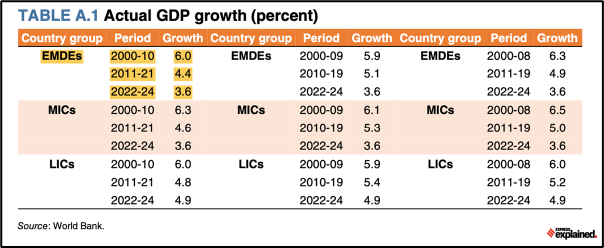Why in News?
- The World Bank, recently, published a report titled “Falling Long-Term Growth Prospects: Trends, Expectations, and Policies”.
- The report offers the first comprehensive assessment of long-term potential output growth rates in the aftermath of the COVID-19 Pandemic and the Russian invasion of Ukraine.
What’s in today’s article?
- About the Report (Key Highlights, Reasons for Slowdown, About India, Suggestions, etc.)
Key Highlights of the Report:
- The report “Falling Long-Term Growth Prospects: Trends, Expectations, and Policies” is published by the World Bank.
- The report uses a comprehensive database of multiple measures of potential growth.
- It examines trends in potential growth and its drivers, global and regional prospects for potential growth and investment over the 2020s, and a range of policy options to lift potential growth.
- It documents three major findings –
- First, there has been a protracted, broad-based decline in potential growth and its underlying drivers.
- Major adverse shocks also reduce potential growth by leaving a lasting impact on these drivers.
- Second, the slowdown in potential growth is expected to persist for the rest of this decade.
- Third, while they are significant challenges confronting emerging market and developing economies (EMDEs), they are not insurmountable.
- It is possible to reverse the slowdown in potential growth and chart a sustained, sustainable, and inclusive growth path by implementing ambitious, broad-based and forceful policies at the national and global levels.
Reasons for the Slowdown:
- The biggest reason for the slowdown is that the EMDEs are in the midst of a prolonged period of weakness.
- The following table shows a broad-based decline over the past two decades whether a country belongs to EMDEs or the middle-income countries (MICs) or the low-income countries (LICs).

- The World Bank has looked at a whole set of fundamental drivers that determine economic growth and found that all of them have been losing power.
- These fundamental drivers include things like –
- Capital accumulation (through investment growth),
- Labour force growth, and
- Growth of total factor productivity (which is the part of economic growth that results from more efficient use of inputs and which is often the result of technological changes) etc.
- Not surprisingly then, the potential growth rate is expected to decelerate further.
Observations about India:
- Even though India has also lost its growth momentum over the past two decades, it is and will likely remain a global leader when it comes to growth rates.
- India falls under the South Asia Region (SAR), which is expected to be fastest growing among emerging market and developing economies for the remainder of this decade.
- To be sure, India accounts for three-fourths of the SAR output.
- SAR includes countries like Afghanistan, Pakistan, Sri Lanka, Nepal and Bangladesh etc.
- Economic activity in the SAR rebounded strongly from the recession caused by the COVID-19 pandemic, expanding by 7.9 percent in 2021.
- Output in the region is on track to grow by about 6.0 percent a year between 2022 and 2030, faster than the 2010s annual average of 5.5 percent.
What can be done to boost potential Global Growth?
- The report highlights specific policy actions at the national level that can make an important difference in promoting long-term growth prospects.
- Align monetary, fiscal, and financial frameworks –
- Robust macroeconomic and financial policy frameworks can moderate the ups and downs of business cycles.
- Policymakers should prioritize taming inflation, ensuring financial-sector stability, reducing debt, and restoring fiscal prudence.
- Ramp up investments –
- Transportation and energy, climate-smart agriculture and manufacturing, and land and water systems.
- In the above mentioned areas, sound investments aligned with key climate goals could enhance potential growth by up to 0.3 percentage point per year.
- Cut trade costs –
- Trade costs—mostly associated with shipping, logistics, and regulations—effectively double the cost of internationally traded goods today.
- Countries with the highest shipping and logistics costs could cut their trade costs in half by adopting the trade-facilitation and other practices of countries with the lowest shipping and logistics costs.
- Capitalize on services –
- The services sector could become the new engine of economic growth.
- Exports of digitally delivered professional services related to information and communications technology climbed to more than 50% of total services exports in 2021, up from 40%in 2019.
- Increase labor force participation –
- About half of the expected slowdown in potential GDP growth through 2030 will be attributable to changing demographics.
- This change includes a shrinking working-age population and declining labor force participation as societies age.
- Boosting overall labor force participation rates by the best ten-year increase on record could increase global potential growth rates by as much as 0.2 percentage point a year by 2030.
- The report also underscores the need to strengthen global cooperation.
- International economic integration has helped to drive global prosperity for more than two decades since 1990, but it has faltered.
- Restoring it is essential to –
- Catalyse trade,
- Accelerate climate action, and
- Mobilize the investments needed to achieve the Sustainable Development Goals.










